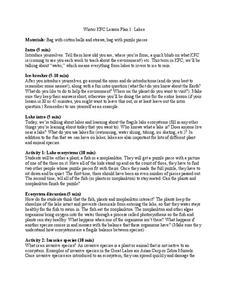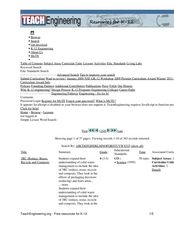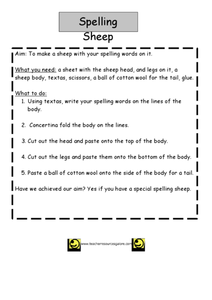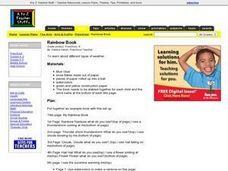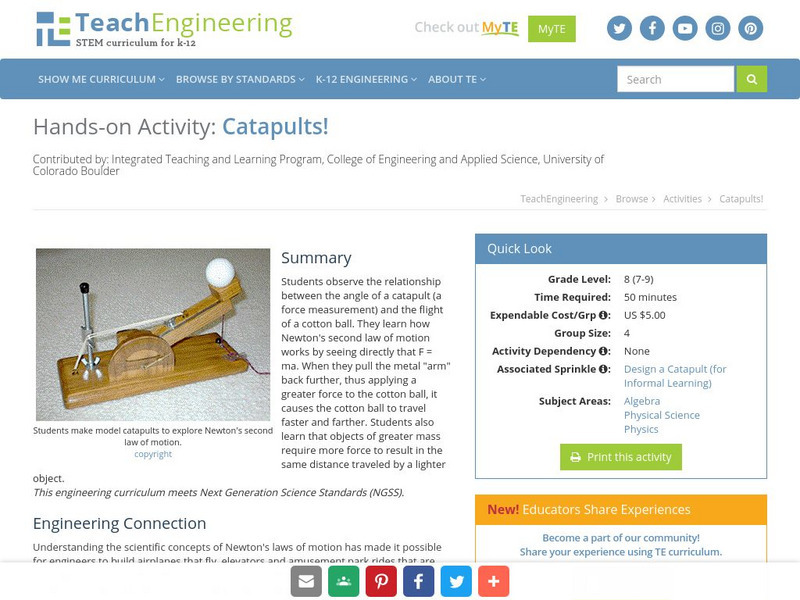Curated OER
Graphs
Students create "snowballs" from crumbled pieces of white paper. They then glue their snowball to the appropriate side of the graph to indicate who has and who has not thrown a snowball. The teacher and the calss then will count how many...
Curated OER
North Carolina State Vegetable -- Day 2
Students are introduced to the state vegetable of North Carolina, the sweet potato. In groups, they create their own sweet potato person using the items from a Mr. Potato Head. They write a summary of their person and a narrative about...
Curated OER
Fats
High schoolers are introduced to the characteristics of fats and their function in the body. In groups, they make a reduced fat recipe of chicken fingers and discuss other ways to reduce fat in their diet. To end the lesson plan, they...
Curated OER
Making Comparisons- School-Home Links
In this grammar worksheet, 2nd graders and parents read about making comparisons between unlike things and the use of similes. They underline the two things that are being compared in 4 sentences. There is a place for both the student...
Curated OER
Lakes
Learners role-play members of an ecosystem. In this lake ecosystems lesson, students simulate various organisms within an ecosystem to discover the impact on the environment.
Curated OER
Conservation
Fifth graders examine how destructive fishing practices affect the health of coral reefs. They watch a Powerpoint Presentation, conduct an experiment, and in small groups create a Powerpoint Presentation.
Curated OER
Thar She Blows
Students discover the effects of El Nino on the global climate. As a class, they role play the role of a cold or warm wind and act out a skit in front of the class. They discuss the results of the role play once it is completed.
Curated OER
Spelling Sheep
Students use a sheep pattern to practice their spelling words. In this spelling lesson plan, students cut and paste sheep images together and write their spelling words on the sheep.
Curated OER
Cells Are Us
Students explore cells. In this science lesson plan, students investigate how the cell is the basic unit of life, that cells divide slowly to become mass of cells, and that there is a gradual loss of cells throughout life.
Curated OER
Clay Pot Winter Friends
Students create ice blue, clay pot winter friends using clay pots, ice blue paints, markers, felt, and fabric in this Art lesson for the winter time. The lesson would be ideal for the early elementary classroom during the winter months.
Curated OER
Ag In The Outfield
Young scholars explore baseball. This is a cross-curricular plan that includes math, history, and agriculture. Pupils use their five senses to observe the materials a baseball is made from and identify the agricultural products used. In...
Curated OER
Historical Summaries: Arizona
For this Arizona history worksheet, students read a 2-page article about prehistoric, Spanish, Mexican, and American Arizona prior to responding to 2 short answer questions.
Curated OER
Which Kind of Sentence
In this type of sentences activity, students read each sentence and write the correct punctuation at the end of the sentence. Students review examples for declarative and interrogative sentence endings. Students complete 10 sentences.
Curated OER
Rainbow Book
Students examine the different types of weather. They create illustrations of the type of weather to go into a class book. They are encouraged to examine the weather each day,
Curated OER
The Circumference and Diameter of a Circle
Ninth graders investigate the finding of the diameter of a circle in order to extend the practice towards finding the circumference. They differentiate between the distance measured across a circle from that of around the perimeter.
TeachEngineering
Teach Engineering: Mechanics Mania
Through ten lessons and numerous activities, students explore the natural universal rules engineers and physicists use to understand how things move and stay still. Together, these rules are called "mechanics." The study of mechanics is...
TeachEngineering
Teach Engineering: Catapults!
Students observe the relationship between the angle of a catapult (a force measurement) and the flight of a cotton ball. They learn how Newton's second law of motion works by seeing directly that F = ma. When they pull the metal "arm"...
Other popular searches
- Cotton Balls for Clouds
- Measuring Area Cotton Balls
- Smoking Cotton Balls
- Salt and Cotton Balls
- Food Web Cotton Balls
- Measring Area Cotton Balls
- Meas Ring Area Cotton Balls




